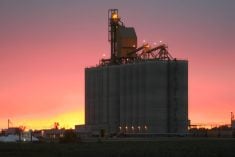Farmers can draw on four decades’ worth of research when making decisions about re-seeding open pollinated canola, but there isn’t much information out there when it comes to hybrid canola.
“Hybrid canola can grow to be a monstrous plant,” says Sherrilyn Phelps, regional crop specialist with Saskatchewan Ministry of Agriculture at North Battleford. “They are just more vigorous and can adapt much better than open pollinated canola.”
Crop insurance investigators have counted pods on plants and measured the effect of plant density. At lower plant populations, there can be upwards of 600 pods on a plant versus more normal plant populations, which would be closer to 100 pods per plant. “Again, this just demonstrates the tremendous (adaptive capability) of this plant,” says Phelps.
Read Also

Cancer agency reclassifies another herbicide ‘probably carcinogenic’
The WHO’s cancer research agency has now put atrazine, a herbicide well known to corn growers, in the same potential-hazard category where the agency put glyphosate.
But this makes it challenging to know when to re-seed.
“Plant populations are important, no doubt,” says Phelps. “But the uniformity of the stand is also very important, really, more of a concern.”
Doug Moisey agrees with Phelps.
“The ideal plant population is around 80 to 100 plants per square metre,” says Moisey, senior agronomy specialist in Central Alberta for the Canola Council of Canada.
“But there is a critical level at about 50 plants per square metre or five per square foot. Even at 20 plants per square metre and with really good management practices, the farmer can get a good yield without reseeding.”
Moisey also points out it’s not plant population alone that is important. “Uniformity within the field and date of reseeding are also critical,” he says.
THE BARE MINIMUM
Steve Shirtliffe, assistant professor with the University of Saskatchewan, and his team did a meta-analysis on all the research going back to the ’70s on re-seeding canola and hybrid canola.
They found that at around 80 to 90 plants per square metre, maximum yield was attained for open pollinated or hybrid types. The study also indicated that much lower plant populations of hybrid canola, around 45 plants per square metre, could sustain yields.
But there are very few studies looking at plant populations below 45 plants per square metre. So what does a farmer do when faced with five or 10 plants per square metre if he or she runs into frost or some other emergence issue?
Phelps, Shirtliff and others are conducting trials to find an answer to two specific questions: What happens to yield at a wide range of plant populations (two to 150 plants per square metre)? And what are the risks of reseeding when populations are lower than 40 plants per square metre?
These two trials began last year at five sites in Saskatchewan — Indian Head, Melfort, Saskatoon, Scott and Swift Current.
“We will run the trials next year, and hopefully for a third year, if we get the funding,” says Phelps. “Important questions will be answered like at what population density will hybrid canola still yield at least 90 per cent of maximum yield; what effect plant population has on maturity, green seed count and seed size; the minimum density at which hybrid canola should be reseeded; and, what risks can reseeding present in terms of maturity, yield and quality.”
NO RE-SEEDING AFTER MAY
In Alberta, Moisey has many years of experience looking at farmers’ crops and has conducted research himself. His opinion on re-seeding?
“Re-seeding past the end of May doesn’t pay,” he says. “We haven’t seen it worthwhile to reseed from the last week of May forward. First off, canola is very plastic and secondly, hybrids are even more so, and will continue to branch. They may not reach their full yield potential, but it wouldn’t be worthwhile reseeding.”
Moisey is a big proponent of getting out into the field and surveying the situation carefully and methodically. He recommends determining if there are huge bare patches or if it is the low spots, mid-slopes or hill tops that are affected.
“Is the field the victim of cutworm? Or hail? Or frost? If the latter, it might be only the lowland that has the problem. And what about dates? If it is still early or mid-May, reseeding might be an option. But if it’s later, I advise guys to really step up the whole management aspect a few notches, being aware they may have to do more than one weed control pass and watch for insects and disease pressure more vigilantly.”
You need to make an informed decision, says Moisey.
“Get out into the field with a hula-hoop and walk the field on a grid, a giant X or inverted W,” he explains.
“I take the hoop and throw it out in front of me. Then I observe the area around the hoop and within it, and ask myself, ‘Is it representative of where I’m standing?’ Do that 20 or 25 times, but also make sure you look at hill-tops, low spots and whatnot to ensure you are getting the true picture of the stand in that field. You might end up taking 40 or more counts.”
Moisey also recommends farmers contact local agronomists or provincial specialists if they are available.
“The Canola Council has good factsheets available, one of which in this case is helpful — managing low plant populations — on its website,” he says.
“There are a lot of resources out there farmers can use to help with these sorts of decisions.”
AndreaHildermanhashermaster’sdegree inweedscienceandisamemberofthe ManitobaInstituteofAgrologists.Shewrites fromWinnipeg,Man.














